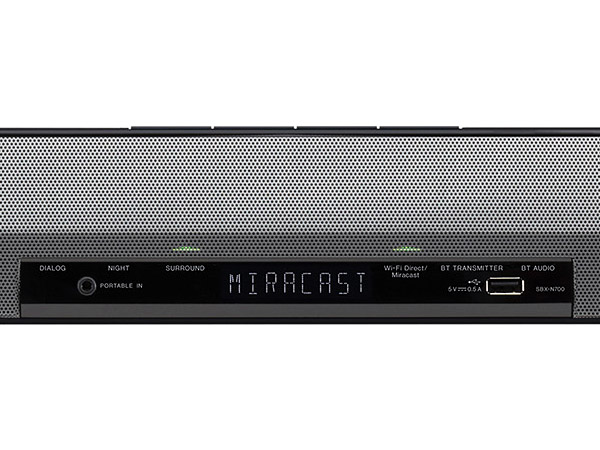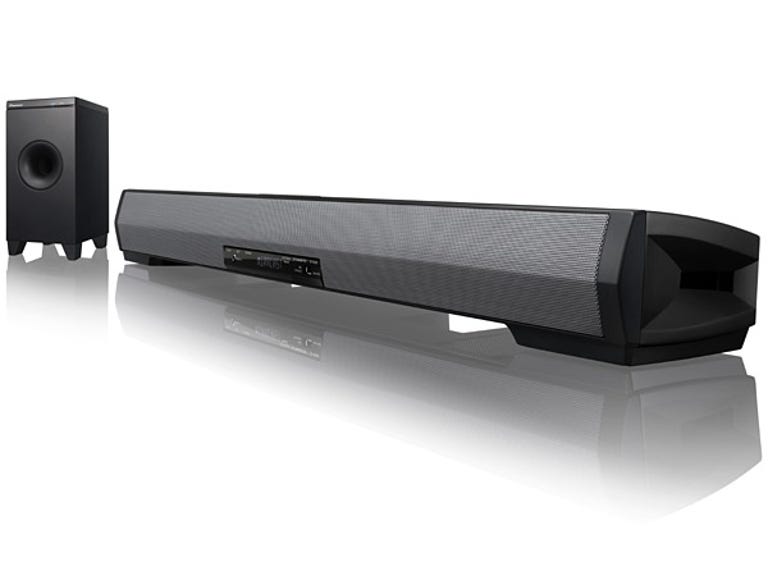 Why You Can Trust CNET
Why You Can Trust CNET Pioneer SBX-N700 Network AV soundbar review: Pioneer SBX-N700 Network AV soundbar
The Pioneer SBX-N700 provides solid sound quality, extraordinary network capabilities and Bluetooth support, all at a very attractive price.
Pioneer's SBX-N700 is, despite the fairly low price, the company's top of the line model in this field. It takes the wise course of providing both soundbar and subwoofer, which of course connect wirelessly (indeed, they are pre-paired). There's also a surprisingly well endowed remote control.
The Good
The Bad
The Bottom Line
The soundbar has four speaker drivers: a pair of 66mm midrange tweeters firing forwards and two 77mm midrange woofers firing downwards. Or do they? We'll see about that later.
As it comes you can install the unit on a wall using the keyhole slots at the back, or just mount it in front of your TV on the entertainment unit.
The subwoofer has a 165mm driver with a surprising 150 watts to drive it.
Now here's where things get interesting. The unit has a HDMI output, but no HDMI inputs. It has two optical digital audio inputs at the back, and an analogue stereo 3.5mm input and USB socket on the front. Between these is an alphanumeric display. There are two other connections at the back: Ethernet and an output for an infrared remote control repeater, which is included with the unit. Actually, there are two IR repeaters built into the back as well, so if the unit is blocking your TV's IR receiver, then these will probably do the trick. But you can use the plug-in one if that doesn't work. Or feed it to a Blu-ray player hidden away in the entertainment unit.
The Ethernet socket may not be required in your home because it also supports WiFi. And WiFi direct in case you want to feed something from your WiFi device but lack the necessary network. And Miracast, so that many modern Android phones can feed HD video and audio to the unit.
Did I miss anything? Oh, of course, the unit also supports Bluetooth. Only one device at a time, but that device need not be a music source — it can also be Bluetooth speakers or headphones. The latter would be useful for nighttime listening.
The purpose of the HDMI output is two-fold. First, because it is Audio Return Channel enabled, it also acts as an input for sound from the TV. Second, it allows your TV to show the unit's full-function, nicely-styled on screen display.
Note, you will need a TV with two HDMI inputs if you want to use a Blu-ray player or some such, three if you want to add a games console, and so on. Without a HDMI input on this unit, it can't pass through video from a different source.

(Credit: Pioneer)
In Use
My goodness, sometimes it's hard not to be dazzled by a proliferation of functions into inappropriate judgements. This unit is loaded with functions, just about all of them being things that I think are both valuable and quite astonishing in a AU$600 system.
We will get to the basic function of this unit — as a decent reproducer of sound for your TV — shortly. But first let us check out those features.
First, what audio formats do the optical inputs support from your TV or disc spinner? Dolby Digital 5.1, it turns out, plus DTS 5.1, plus two channel PCM all the way up to 96kHz sampling and 24 bits of resolution. Most inexpensive soundbars choke somewhere in there.
As for digital media files served up from the network (yes, there's very effective DLNA support, including page skipping for navigating quickly through long media lists), the only test files that the unit would not play were the very high-end Direct Stream Digital, and MPO 3D still photos. For music it worked with MP3, WMA, WAV, APE, and FLAC. With the last that included 192kHz, 24 bits, and 5.1 channel 96kHz, 24 bits. Few devices support that last one. It showed photos, it ran video from my server and, as mentioned, it supports Miracast — although I prefer to feed video and audio via DLNA where possible. With this soundbar that was indeed possible, and it showed up as a playback device on my Android devices, and happily accepted the HD video I sent it.
What's all this stuff doing in a soundbar? It's a bit shocking.
The only Internet content directly supported is YouTube. Did I just write 'only'?
The unit is controllable, of course, by its remote, and also by means of the Pioneer control app available for both iOS and Android. It looked a touch nicer on an iPod Mini than on a Samsung 8 inch tablet, but the functionality was about the same. You can set the unit to be able to be awakened from sleep mode by the app.
Now after all this, the question must be: 'how bad does it sound'? I was kind of fearing the worst. But it wasn't bad at all, especially with stereo.
As seems to be bit of a theme with these subwoofer supported soundbars, the subwoofer was way too loud by default, and still a bit loud when turned down to its minimum. Digging around in the setup menus didn't find a solution to that, but it did reveal the ability to specify the distances between the listening position and the soundbar, and between the listening position and the subwoofer. I had the latter about 2.5 metres further away. Dialling in the correct measurements tightened up the integration of the two units considerably, tying the relatively non-directional bass from the subwoofer firmly to the directional upper frequencies of the soundbar.
The menus also revealed something quite unexpected, you can set Subwoofer to either the wireless external unit, or to the built in downwards firing speakers. If you're using the former, the latter just sit their idly doing nothing at all. If you're using the system late at night, you could manually switch over to the built in speakers in order to avoid troubling neighbours.
The overall character of the sound was a touch forward and pushy, with cymbals quite zinging out on some music and occasionally a touch of sibilance with male singers. With movie and TV dialogue, though, the system was clean and coherent. And aside from that slight peakiness in the upper register, the bar was surprisingly well balanced. It also went reasonably loud when advanced to full volume, and remained pretty much undistorted.
The subwoofer was surprising. I was thinking that the 30 hertz seemed a bold claim, but once the music started playing I was thinking that a good solid 40 hertz at least seemed to be in play.
Measuring in my room, there was certainly a peak in the high frequency. It was higher than I expected, peaking at nearly 12kHz, above which the response rolled off fairly quickly. The bottom end measured in my sitting couch, the subwoofer reached comfortably down to 45 hertz, not quite as deeply as I expected.
Conclusion
You can probably do a little better sound quality wise for the price than the Pioneer SBX-N700 — but weighed against that is the extraordinary feature set, in particular excellent support for all the content available on your network.


